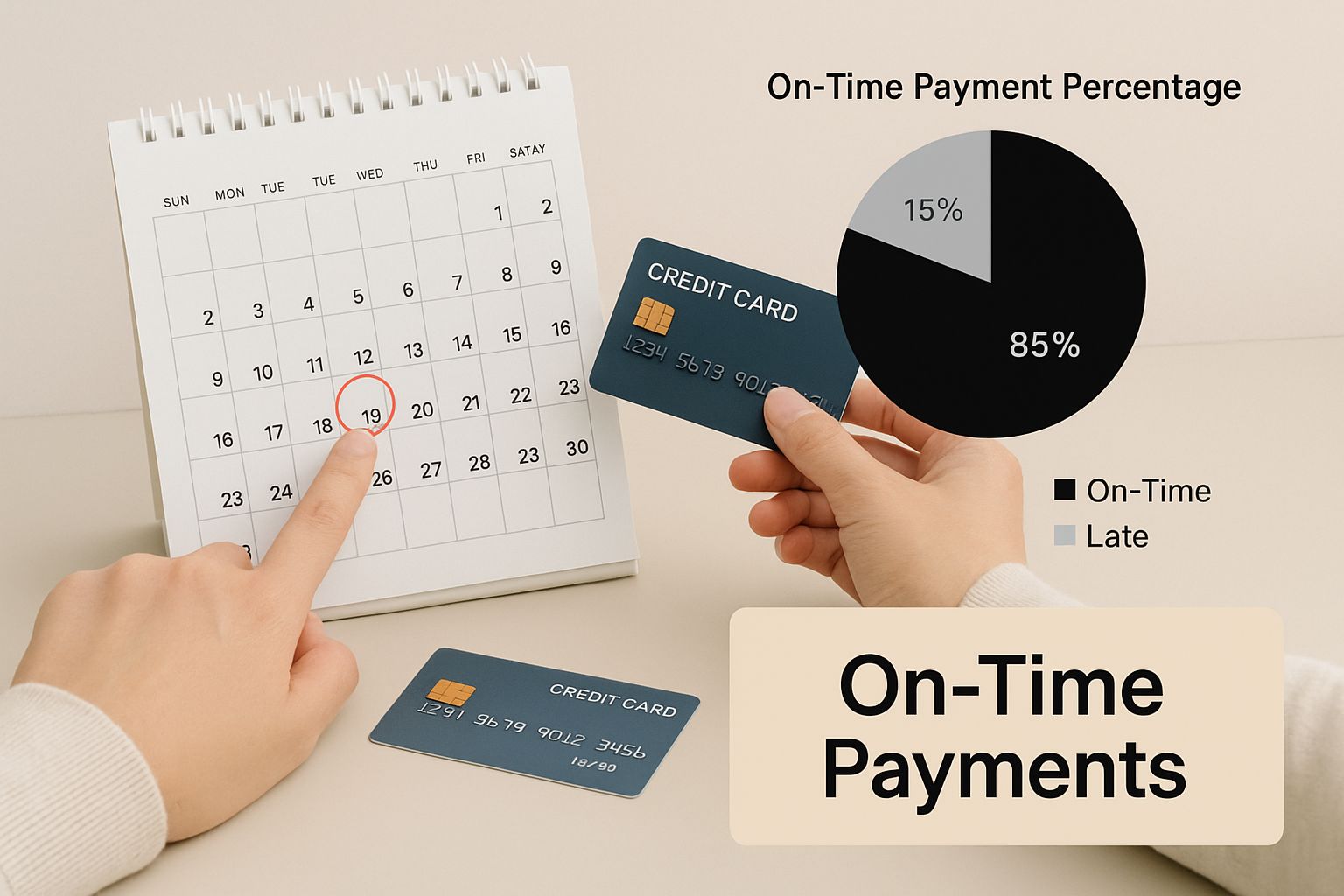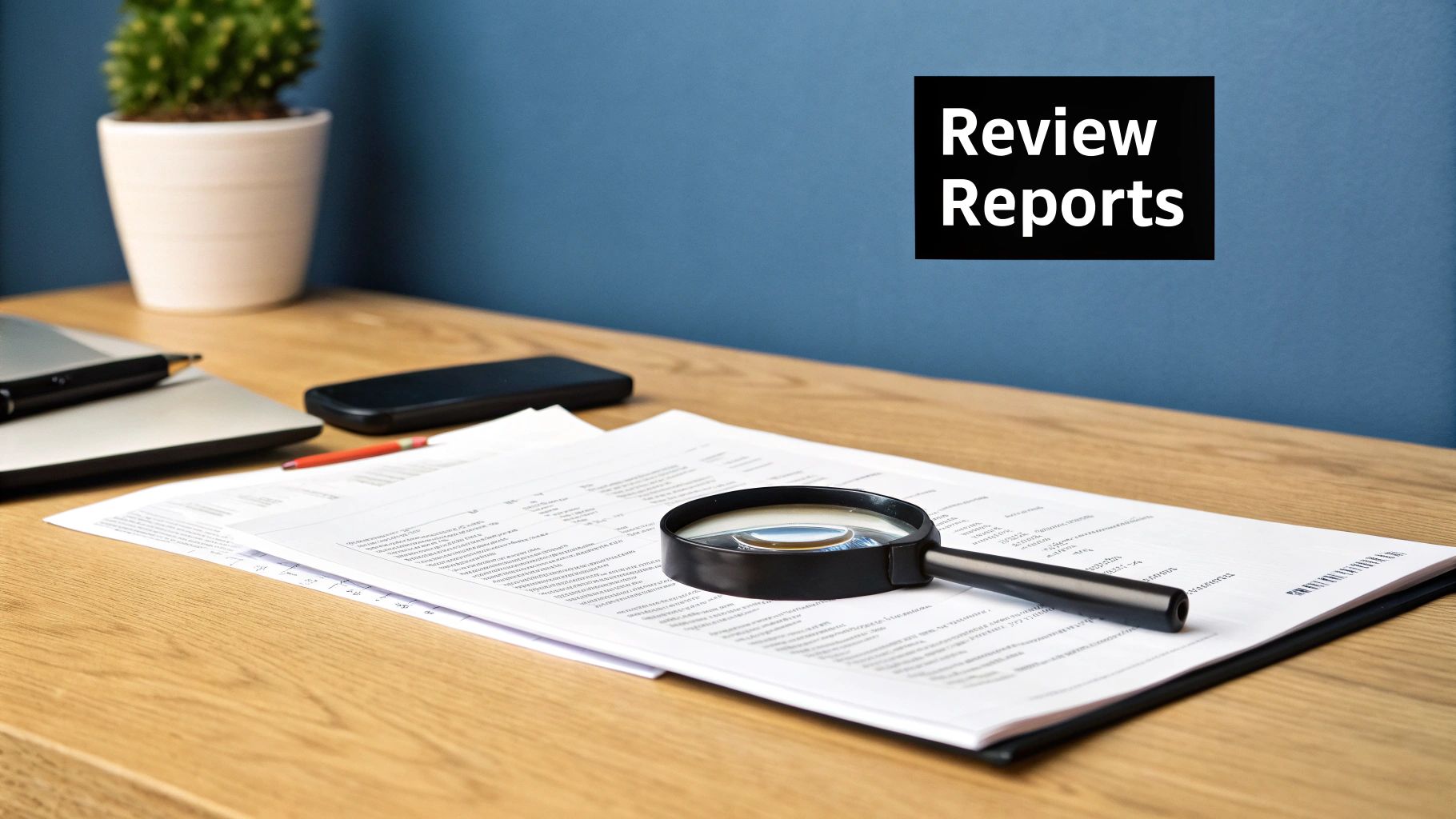How to Maintain Good Credit Score: Proven Tips to Succeed

Building a great credit score is one thing, but keeping it high is a whole different ballgame. It really comes down to a handful of consistent habits. The secret isn't some complicated formula; it's about proving you're a reliable borrower over the long haul by paying bills on time, not maxing out your cards, holding onto older accounts, managing different types of credit, and being strategic about when you apply for more.
Master these, and you’re building a foundation for lasting financial health.
The Blueprint for a Healthy Credit Score
Think of your credit score not as a single grade, but as a living, breathing summary of your financial habits. Lenders look at a mix of factors to gauge how likely you are to pay back what you owe. Once you understand what they’re looking for, you can stop guessing and start focusing your energy on what truly moves the needle.
The biggest piece of the puzzle, by far, is your payment history. It makes up a massive 35% of a typical FICO score. Nothing, and I mean nothing, builds and protects your score more effectively than a long, unbroken streak of on-time payments.
This is all about consistency. It's a routine, month-in and month-out habit.

This isn’t just about avoiding a late fee here and there. It’s about building a reputation with lenders that you’re someone they can trust with their money.
The Key Scoring Factors
Paying on time is critical, but it’s not the only thing that matters. Several other elements come together to form your complete credit profile.
Right behind payment history is your credit utilization ratio. This is simply the amount of credit you're using compared to your total available credit. Even if you never miss a payment, carrying high balances can be a red flag for lenders, suggesting you might be stretched too thin financially.
The length of your credit history also carries significant weight. Lenders love to see a long track record. This is exactly why experts always advise against closing your oldest credit card—doing so can shrink the average age of your accounts and potentially ding your score.
Finally, be mindful of new credit. Every time you apply for a loan or card, it usually results in a hard inquiry on your report. A flurry of these in a short time can make lenders nervous, as it might signal that you’re in financial trouble and desperately seeking credit.
To help you visualize how it all fits together, I've broken down the five core components of your score.
The 5 Pillars of Your Credit Score
This table outlines the five factors that determine your credit score, what they represent, and why they're so important to lenders.
Getting a handle on these five pillars is the first real step toward taking control of your credit. When you know the rules of the game, it's much easier to win.
Master Your Payment History Like a Pro

When it comes to your credit score, nothing carries more weight than your payment history. It's the big one, accounting for a massive 35% of your FICO score. Everyone knows the golden rule is "pay your bills on time," but life happens. A forgotten due date can trip up even the most organized person, which is why having a solid system is non-negotiable for keeping your score high.
This goes way beyond just dodging late fees. It's about building a rock-solid track record that shows lenders you're reliable. What they really want to see is a long, consistent history of on-time payments. Just one payment reported late can knock a great score down by a surprising number of points, and that negative mark will haunt your report for seven long years.
Build a Bulletproof Payment System
Hope is not a strategy. To make on-time payments a reflex, you need a practical system that works for you. The aim is to make it almost impossible to miss a due date.
A great place to start is with strategic autopay. I don't mean turning it on for every single bill without a second thought. Be smart about it. Use autopay for your fixed bills—think mortgage, rent, or a car loan. For credit cards, where the balance changes monthly, set autopay for at least the minimum payment. This acts as your safety net. It guarantees you'll never be marked as "late," but still gives you the control to log in and pay the full balance before the due date.
Next, you need to turn your calendar into your financial command center. A single reminder just won't cut it. For each bill, I recommend setting up a series of alerts:
This layered approach means that if one notification slips by, another is there to catch you. It's a simple tweak, but it's incredibly effective at keeping you ahead of the game.
When You Know a Payment Will Be Late
Let's be realistic. Sometimes, a tight month makes paying on time feel impossible. If you see a late payment on the horizon, the absolute worst thing you can do is ignore it and hope for the best.
Pick up the phone and call your creditor before you miss the payment. Calmly explain the situation and ask what your options are. Can they offer a temporary hardship plan? Would they be willing to waive the late fee as a courtesy? You'd be surprised how often they're willing to work with you, especially if you've been a good customer. That single phone call can be the difference between a temporary cash crunch and a seven-year blemish on your credit report.
Building and protecting a flawless payment history is the bedrock of excellent credit. By setting up these simple systems—smart autopay, layered reminders, and honest communication—you turn a good intention into a powerful, score-boosting habit.
Keep Your Credit Utilization in Check
After on-time payments, the next biggest piece of the credit score puzzle is your credit utilization ratio (CUR). It sounds complicated, but it’s simply the amount of credit you're using compared to the total amount you have available.

Lenders pay very close attention to this number. Why? It's their quickest way to see how much you rely on borrowed money to get by from month to month.
Let's break it down. Say you have one credit card with a 10,000 limit**. If you have a **3,000 balance on it, your CUR is 30%. Understanding this simple math is critical. A consistently high utilization ratio can be a red flag for lenders, making them think you're under financial stress—even if you always pay on time.
Beyond the 30 Percent Rule
You've probably heard the old rule of thumb: keep your credit utilization below 30%. That’s not bad advice, and it’s a decent starting point for general credit health. But if you want to really optimize your score, you need to think a little more strategically.
When you're gearing up for a big financial move, like buying a house or a car, aiming even lower can give you a serious advantage. In my experience, dropping your utilization to under 10% in the months before applying for a loan sends a very strong message to lenders that you have your finances on lockdown.
Here's how I think about it in tiers:
This isn't just about numbers; it's about showing you're a responsible borrower. That discipline can directly translate into better loan terms and lower interest rates.
Smart Tactics to Lower Your Utilization
Getting your utilization down doesn't always require you to slash your spending. There are a few clever moves you can make. One of the most effective tricks is to make a payment before your statement closing date.
Here's how it works: Your card issuer usually reports your balance to the credit bureaus just once a month, right after your statement period ends. If you pay off a big purchase a few days before that closing date, the balance that gets reported will be significantly lower. Your utilization for that month plummets instantly.
Spreading your spending across a couple of different cards can also be a smart play, as it helps keep the utilization low on any one card. Lenders look at both your overall CUR and the ratios on individual accounts.
At the end of the day, how you manage your available credit is a huge indicator of your financial health. Data consistently shows a clear link between lower utilization rates and higher credit scores, with the under 30% mark being a key threshold. You can dig deeper into these patterns by exploring the latest global consumer credit trends at Equifax.com.
Build and Protect Your Credit History
https://www.youtube.com/embed/zsVBjcLP5zc
Keeping a high credit score isn't just a short-term game; it’s about building a long story of financial reliability over many years. Think of it this way: a long, well-managed credit history is one of the clearest signals you can send a lender that you're a safe bet. This single factor actually accounts for 15% of your FICO score.
It's easy to get the urge to simplify your wallet by closing old credit cards you don't use anymore. But be careful. That old, no-fee card you've had since college, sitting in the back of a drawer? It might just be one of your most powerful credit-building tools.
Closing it can backfire in two ways. First, you instantly shorten the average age of all your accounts. Second, you lose that account's credit limit, which shrinks your total available credit. This can cause your credit utilization ratio to jump up, even if your spending hasn't changed a bit.
When to Keep and When to Close Accounts
Holding onto your oldest accounts is almost always the right move, especially if they don’t have an annual fee. They act as the anchors for your entire credit profile. Even if you don't use the card for daily purchases, just making one small purchase every few months—like a coffee or a subscription—and paying it off right away keeps the account active and working in your favor.
Of course, there are times when closing an account makes sense. If an old card comes with a steep annual fee and the perks no longer outweigh the cost, it might be time to part ways. But before you snip the plastic, call the card issuer. Ask if you can downgrade to a no-fee card in their lineup. More often than not, they'll let you switch, allowing you to ditch the fee while keeping your precious account history intact.
Create a Healthy Credit Mix
Lenders don’t just look at the age of your accounts. They also want to see that you can successfully juggle different types of debt. This is what's known as your credit mix, and it influences about 10% of your score.
A healthy mix usually contains both revolving credit and installment loans.
Successfully managing both types demonstrates that you can handle a range of financial commitments. Now, you should never take on debt just for the sake of your credit mix. But as your financial life naturally grows to include things like a car loan or a mortgage, you'll build a more diverse and robust profile. Keeping tabs on how these different accounts are reported is key, and you can learn more about the roles of all three credit bureaus in our detailed guide. This balanced approach helps solidify your reputation as a trustworthy borrower, opening the door to better financial opportunities down the road.
Become a Vigilant Credit Monitor
You can't just build a great credit score and then walk away. Think of your credit reports as the official story of your financial life. If you aren't checking them regularly, you're essentially letting someone else control that narrative—and they might get it wrong. Honestly, making a habit of monitoring your credit is the single best thing you can do to catch problems before they snowball.
This vigilance is your first line of defense against costly reporting errors or even identity theft, both of which can absolutely tank a score you've worked hard to build. You're legally entitled to see your own reports for free, so there’s really no excuse for being left in the dark.
Your Routine Credit Checkup
The big three credit bureaus—Equifax, Experian, and TransUnion—each keep their own file on you. While a lot of the information overlaps, they are separate companies. This means a mistake could pop up on one report but not the other two.
That’s why you absolutely have to check all three. The best place to start is AnnualCreditReport.com; it's the only source authorized by federal law for your free weekly credit reports. I tell people to set a recurring reminder on their phone or calendar. A smart strategy is to pull a report from a different bureau every four months. This way, you get a staggered, year-round view of your credit without feeling overwhelmed.
When you pull a report, don't just give it a quick glance. You need to be a detective and look for specific red flags:
Taking Action on Errors
If you find something wrong on any of your reports, you have the right to dispute it with the credit bureau. The process itself isn't complicated, but you have to be organized.
Here’s a game plan for filing a dispute that gets results.
First, gather your proof. Before you even start the dispute, pull together any documents that back up your claim. This could be a bank statement showing a payment cleared on time, a letter from a lender confirming an account was closed, or even a police report if you're dealing with fraud.
Next, submit the dispute. The quickest way is through each bureau's online dispute portal. You'll need to clearly explain what's wrong and why you believe it's an error. Then, upload copies—never the originals!—of the proof you collected.
Finally, you follow up. The law gives the credit bureaus about 30 days to investigate your claim by contacting the company that reported the information. After their investigation, they have to send you the results in writing. If they make a change, you'll also get a free, updated copy of your report.
Making this a regular habit is fundamental for anyone serious about maintaining a good credit score. It shifts you from being a passive observer to the active guardian of your own financial reputation. For a deeper dive into this, our guide on credit monitoring for all three bureaus offers even more great insights.
Common Questions on Maintaining Credit
Even with a great strategy, real life throws curveballs that can make you second-guess your credit decisions. Knowing how to navigate these common scenarios is what separates a good score from a great one and helps you steer clear of those easy-to-make mistakes.
A question I hear all the time is about paying off old loans. It feels like a major victory to finally close out that student loan or car payment, but then your score dips slightly. What gives? This usually happens because closing an installment loan can tweak your credit mix, which makes up about 10% of your score. The drop is almost always small and temporary. In the long run, being debt-free is a much bigger win than worrying about a tiny, short-lived fluctuation. If you're seeing a more significant change, it's worth digging into the reasons why your credit score might be dropping to see what's really going on.
Can I Use My Credit Card Too Little?
Here's another classic question: can you use a credit card so little that it backfires? Absolutely. If you have a card—especially an older one—gathering dust in a drawer, the issuer might just close the account for you.
When that happens, it can sting your score in two ways:
Luckily, the solution is simple. Take that old, no-fee card and link it to a small, recurring charge, like a streaming subscription. Then, just set up autopay to pay it off in full every month. The account stays active and continues to help your score with basically zero effort on your part.
This kind of discipline is exactly how so many people reach elite credit status. Take a look at the data—a recent Experian report revealed that nearly 23% of U.S. consumers have a FICO score of 800 or higher. These are people who have mastered the fundamentals of on-time payments, low utilization, and a long credit history. If you're curious, you can get more details from the full analysis of how many Americans have an 800 credit score.